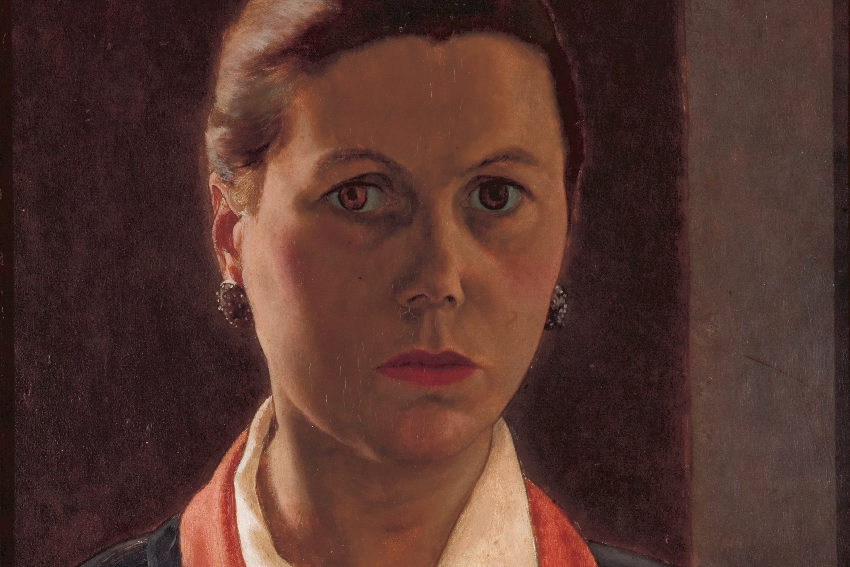Stella Bowen: Drawn From Life

On the 70th anniversary of Stella Bowen’s death, one of this state’s best poets responds to her courageous and haunting self-portrait, which hangs in the Art Gallery of SA.
Stella Bowen’s self-portrait in the Art Gallery of South Australia has long haunted me. Something in the intensity of her stare always makes me seek it out. Bowen grew up in middle class comfort in North Adelaide before the First World War. She sailed for England in 1914 and never came back. Studying painting and meeting the novelist Ford Madox Ford, she lived with him in poverty in England and France. They had a daughter and settled in Paris where Bowen found herself in the epicentre of modernism; Ezra Pound, James Joyce, Gertrude Stein, Pablo Picasso, T.S. Eliot ate at her table.
She painted this self-portrait in about 1930. She had already separated from Ford because of his predilection for affairs with younger women. Bowen supported herself and her daughter with painting portraits and her small allowance from home, but the Depression had arrived, and she was about to lose her apartment in Paris.
This ekphrastic poem is my response to Bowen’s courageous self-portrait. I imagine her staring both at us as viewers and at herself, looking back on her life and into her own future. Stella Bowen died in England on October 30, 1947. She had wanted to return to Australia, but was denied a pension, or assistance with the passage. The quoted lines in the poem are from Bowen’s 1941 memoir, Drawn from Life.

Stella Bowen, Australia/Britain, 1893 – 1947, Self portrait, c.1929, Paris, oil on plywood; Gift of Suzanne Brookman, the artist’s niece, through the Art Gallery of South Australia Foundation 1999, Art Gallery of South Australia, Adelaide
STELLA BOWEN SELF-PORTRAIT circa 1930
A stern teacher demanding
exact answers from herself.
That enormous right eye,
centre of the painting
lit up amber – a caution,
a statement about seeing.
Black, white, ochre layers of dress,
the asymmetrical collar pointing left,
clasp earrings,
a turquoise studded brooch,
the drawstring of an artist’s smock,
a slightly puritanical mouth.
Warm light falls on the right side of her face,
a fineness of chestnut hair –
you could place your hand
into the picture,
stroke that hair just above the temple
knowing just how it would feel.
Her stare unsentimental,
wary of her own parochialism,
the hometown she remembered before WW1:
“a queer little backwater of intellectual timidity,
“prettyish, banal and filled to the brim
with an anguish of boredom.”
Mills Terrace, North Adelaide. Upper Middle Class:
tennis and roses, church and servants, and heat.
Now imagine briefly she’s not looking in a mirror,
but at you, the viewer –
she’s just caught you in a fib
or some small-mindedness,
something she knows doesn’t add up.
You are judged and found wanting.
Your report says
“must do better.”
But turn the gaze back to its real subject –
the gazer herself.
Anger tightens the jaw.
Is she thinking of lost time,
how she demoted herself
to housekeeper for Ford Madox Ford?
Her painting pushed back behind his novels
while she cooked and dealt with the bills?
Is she thinking of his new younger woman,
taking her place as she once took another’s?
She looks squarely into the face of the Great Depression,
36 years old, a daughter to support,
her life in Paris disappearing
with the exchange rate.
She knows Capitalism doesn’t work
but can’t believe in Communism either.
She sees the rise of the dictators,
her old friend Ezra spruiking Mussolini.
She sees how she must hawk herself
doing family portraits of the rich who are still rich –
but this one is just for her.
Anger is too simplistic.
She takes some pride in the 20s,
the intellectual adventure with Ford
The Transatlantic Review,
the company of Eliot, Joyce and Stein.
She knows the first war was for nothing,
the dead delusions.
She wanted a female “arts of peace”
but couldn’t join the Modernist project,
she loved the Quattrocento too much
to paint like the Cubists.
Her flat in the rue Boissonnade has cost her dearly
and now its value is crashing.
This is serious.
She stares hard into the future:
a Second World War,
survival in England,
perhaps all the way to her own death,
not enough money in the bank to come home –
finally wanting again the “sky almost empty of blue”
“the yellow ochre of the dried grass.”